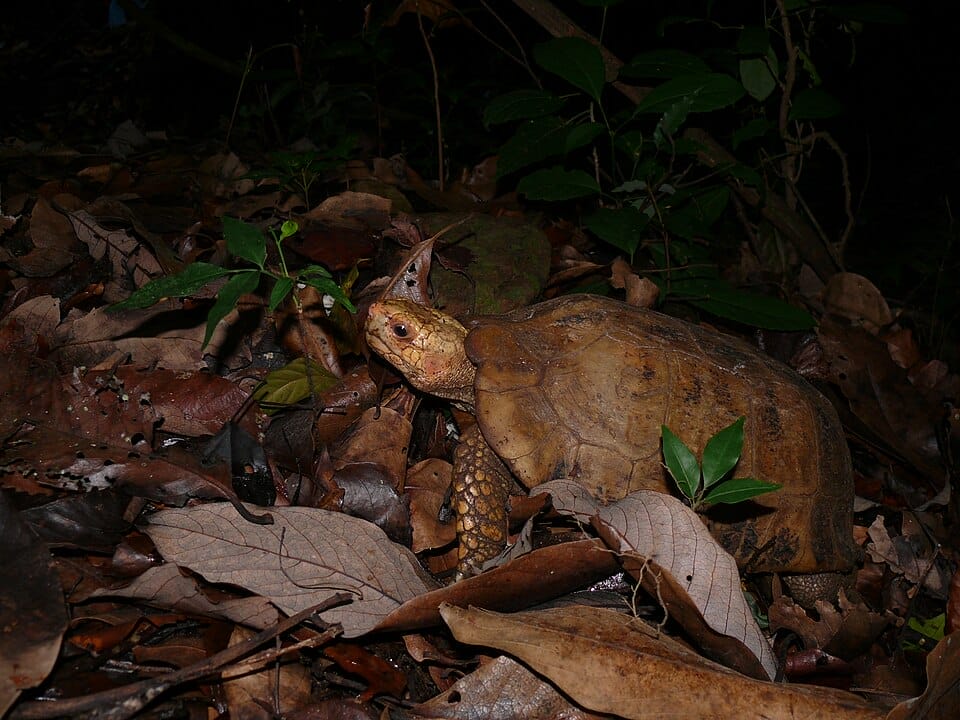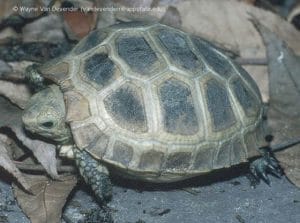Indotestudo travancorica (Travancore Tortoise)
Home > Turtle Database > Indotestudo travancorica (Travancore Tortoise)
Indotestudo travancorica, commonly known as the Travancore Tortoise, is a unique species of tortoise native to the southwestern regions of India. Renowned for its distinctive shell patterns and ecological significance, this species plays a vital role in its native habitat. Conservation efforts are crucial to ensure its survival amidst growing environmental challenges.
Native Turtle Species Map – Find Turtles by Region
Scientific Classification
- Kingdom: Animalia
- Phylum: Chordata
- Class: Reptilia
- Order: Testudines
- Family: Testudinidae
- Genus: Indotestudo
- Species: Indotestudo travancorica
Common Names
- Travancore Tortoise
- Travancore Pond Turtle
- Indian Travancore Tortoise
This Hilarious Turtle Book Might Know Your Pet Better Than You Do
Let’s be real—most turtle care guides feel like reading a textbook written by a sleep-deprived zookeeper.
This one’s not that.
Told from the snarky point of view of a grumpy, judgmental turtle, 21 Turtle Truths You’ll Never Read in a Care Guide is packed with sarcasm, sass, and surprisingly useful insights.
And hey—you don’t have to commit to the whole thing just yet.
Grab 2 free truths from the ebook and get a taste of what your turtle really thinks about your setup, your food choices, and that weird plastic palm tree.
It’s funny, it’s honest, and if you’ve ever owned a turtle who glares at you like you’re the problem—you’ll feel seen.
Identification
Description
The Travancore Tortoise is characterized by its dome-shaped, sturdy shell adorned with intricate patterns of dark and light scales. Adults typically reach a carapace length of 20-25 centimeters. The skin is generally a mottled brown with patches of yellow or orange, providing effective camouflage in their natural habitat. Distinctive markings on the plastron (the underside of the shell) help in species identification.
Sexual Dimorphism
Sexual dimorphism in Indotestudo travancorica is subtle but noticeable. Males usually have longer, thicker tails and more pronounced cloacal openings compared to females. Additionally, males may exhibit brighter coloration during the breeding season to attract mates, while females tend to have a more subdued appearance.
Check more turtles from the Indotestudo genus
Native Origin and Distribution
Geographical Range
The Travancore Tortoise is endemic to the southwestern regions of India, primarily found in the states of Kerala and Tamil Nadu. Their distribution is concentrated around the Travancore plateau, which provides the ideal environmental conditions necessary for their survival.
Preferred Habitat
Indotestudo travancorica thrives in a variety of habitats, including tropical moist forests, wetlands, and riverine environments. They prefer areas with abundant vegetation, which offers both food sources and protection from predators. Ponds, marshes, and slow-moving streams within these regions are common habitats for this species.
Behavior
Feeding Habits
The Travancore Tortoise is primarily herbivorous, feeding on a diverse diet of grasses, leaves, fruits, and aquatic plants. They may occasionally consume small invertebrates or carrion, especially during periods of scarcity. Their foraging behavior is mostly diurnal, with peak feeding activities occurring in the early morning and late afternoon.
Predators
Natural predators of Indotestudo travancorica include large birds of prey, such as eagles and hawks, as well as carnivorous mammals like wild dogs and leopards. Juvenile tortoises are particularly vulnerable to predation by snakes and small mammals. Human activities, including poaching and habitat destruction, also pose significant threats to their survival.
Reproduction
Breeding Season
The breeding season for the Travancore Tortoise typically occurs during the monsoon months, from June to September. This period provides optimal conditions for nesting and the availability of food resources necessary for the growth of hatchlings.
Reproductive Method
Indotestudo travancorica exhibits oviparous reproduction, with females laying clutches of 2-6 eggs in burrows or secluded nesting sites. The incubation period lasts approximately 60-80 days, depending on environmental conditions. Hatchlings emerge fully formed and are independent from birth, receiving no parental care.
Conservation
Extinction Status
The Travancore Tortoise is currently listed as Vulnerable on the IUCN Red List of Threatened Species. Its populations have been declining due to various anthropogenic factors, necessitating immediate conservation actions.
Threats
Primary threats to Indotestudo travancorica include habitat loss due to deforestation, urbanization, and agricultural expansion. Illegal collection for the pet trade and traditional medicine also contribute to their declining numbers. Additionally, pollution of aquatic habitats and climate change pose long-term risks to their survival.
Conservation Measures
Conservation efforts for the Travancore Tortoise involve habitat protection and restoration, strict enforcement of anti-poaching laws, and the establishment of protected areas within their natural range. Breeding programs in captivity aim to bolster wild populations, while community education initiatives promote awareness and sustainable practices to reduce human impact.
Economic Importance
While not directly significant to major economic sectors, the Travancore Tortoise contributes to the ecosystem by maintaining vegetation balance and serving as an indicator species for environmental health. Ecotourism initiatives focused on wildlife observation can also provide economic incentives for local communities to engage in conservation efforts.
Interesting Facts
- The Travancore Tortoise has a remarkable ability to regenerate damaged shell sections, a rare trait among tortoise species.
- This species exhibits homing behavior, often returning to the same nesting sites year after year.
- Local folklore in Kerala attributes various medicinal properties to the tortoise, leading to both reverence and exploitation.
- Indotestudo travancorica plays a crucial role in seed dispersal for several native plant species, aiding in forest regeneration.
- Genetic studies suggest that the Travancore Tortoise has a high degree of genetic diversity, which is vital for its adaptability and resilience.

About Author
Muntaseer Rahman started keeping pet turtles back in 2013. He also owns the largest Turtle & Tortoise Facebook community in Bangladesh. These days he is mostly active on Facebook.














